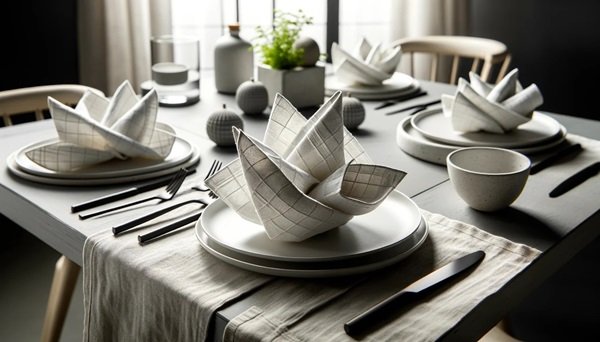
Napkins
Introduction
Napkins are an essential part of any dining experience. Whether you’re hosting a formal dinner, planning a casual family meal, or organizing a grand event, napkin play a crucial role in enhancing both the table’s aesthetics and the practical aspects of dining. But with so many different types, materials, and styles available, choosing the right napkings can seem overwhelming.
In this comprehensive guide, we’ll explore everything you need to know about napkin, from their history and different types to how to choose the perfect napkin for your next occasion.
History of Napkins
The use of napkin dates back to ancient times. Historians believe that ancient Greeks and Romans used pieces of bread or cloth to wipe their hands while dining. As table manners and dining practices evolved, so did the napkin. By the Middle Ages, napkin became more formalized, and by the 18th and 19th centuries, they were a standard feature in European dining. Today, napkin are not just practical but also an important aspect of table décor, adding elegance and style to meals and events.
Types of Napkins
There are several different types of napkin to consider, each suited for specific occasions or uses:
- Paper Napkin: Ideal for casual dining or outdoor events, paper napkin are disposable and come in various designs, colors, and sizes.
- Cloth Napkin: Typically made from cotton, linen, or polyester, these napkin are reusable and perfect for formal occasions, weddings, or upscale dining.
- Cocktail Napkin: Smaller in size, cocktail napkin are used during cocktail hours or casual drinks and are often seen at parties.
- Disposable vs. Reusable Napkin: While paper napkin are disposable and convenient, cloth napkin offer a more sustainable, eco-friendly option.
Materials Used in Napkin Production
Different napkin materials serve different needs. The most common options include:
- Cotton Napkins: Soft, durable, and absorbent, cotton napkins are a popular choice for both home and formal dining settings.
- Linen Napkins: Known for their high-end look and feel, linen napkins add elegance to any table. They are breathable, strong, and improve with each wash.
- Polyester Napkins: Polyester napkins are more stain-resistant and wrinkle-free, making them ideal for busy events or restaurants.
- Eco-Friendly Napkins: Made from recycled paper or natural fibers, eco-friendly napkin are a great choice for those looking to reduce waste.
Napkins for Different Occasions
Choosing the right napkin can enhance the theme and atmosphere of your event. Here’s a breakdown of the best napkin for various occasions:
- Formal Dining and Events: Cloth napkin made from linen or cotton are perfect for formal dinners or upscale events.
- Casual Dining: Paper napkins work well for casual meals or family gatherings, offering convenience and easy cleanup.
- Weddings and Celebrations: Personalized or monogrammed cloth napkin add a touch of luxury to wedding receptions or milestone events.
- Outdoor and Picnic Use: For outdoor picnics or BBQs, sturdy paper napkin are practical and easy to dispose of.
Napkin Sizes and Shapes
Napkins come in different sizes depending on their intended use:
- Standard Napkin Sizes: The most common sizes are dinner napkin (20×20 inches) and cocktail napkin (5×5 inches). Luncheon napkins tend to be slightly smaller (13×13 inches).
- Square vs. Rectangular Napkins: While square napkin are most common, rectangular napkin are sometimes used for unique table settings or to create a different visual impact.
- Specialty Napkin Shapes: For events like weddings, specialty napkin shapes or custom-folded napkin can elevate the look of the table.
How to Fold Napkins for Elegant Presentation
Napkin folding can add a decorative touch to your table:
- Basic Napkin Folds: The simplest fold involves folding the napkin into a square or rectangle and placing it flat on the plate or to the left of the fork.
- Advanced Decorative Folds: For more intricate table settings, you can fold napkin into fans, roses, or pocket folds to hold silverware. Using napkin rings can also give a polished, elegant look.
Napkin Etiquette
Using a napkin properly is a sign of good manners. Here are some tips on napkin etiquette:
- Placing Your Napkin: When seated, place the napkin on your lap as soon as the meal begins. Fold it loosely if needed.
- Using the Napkin: Dab your mouth gently, rather than wiping it forcefully. If you leave the table, place the napkin on your chair.
- Napkin Dos and Don’ts: Never tuck the napkin into your shirt collar at formal dinners, and avoid using it to wipe food off your face.
Custom and Themed Napkins
For special events or themed parties, custom napkin are a great way to enhance the occasion:
- Printed and Monogrammed Napkins: Custom napkin with printed designs, logos, or initials are often used for weddings or corporate events.
- Themed Napkins: Holiday napkins with Christmas or Halloween designs can add a fun element to seasonal parties.
- Personalized Napkins: Offering personalized napkin with guests’ names or event details adds a personal touch to gatherings.
Eco-Friendly and Sustainable Napkin Choices
With growing awareness around sustainability, eco-friendly napkin have become a popular choice:
- Reusable Cloth Napkins: By using cloth napkin instead of disposable ones, you can reduce waste and contribute to a more eco-friendly lifestyle.
- Biodegradable Paper Napkins: Look for napkin made from recycled paper or biodegradable materials that break down quickly in landfills.
- Sustainable Practices: Using cloth napkin for everyday meals instead of paper can make a big difference over time.
Conclusion
Napkins are far more than just a practical item at the dinner table—they can elevate the entire dining experience. Whether you’re hosting a casual meal at home or planning an extravagant event, choosing the right napkin can help set the tone, provide comfort, and even make a statement. From cloth napkin for formal dining to customized napkin for special occasions, the options are endless. And with sustainable napkin choices, you can feel good about minimizing your environmental impact.




